Panhandlers’ plight: They’ve lived at this intersection for years. Is there any way out?
Kenneth “Kenny” Miller and Mark “Lefty” Jacobson are well aware that a lot of people simply don’t want to see them.
They know that a lot of people don’t want to see the men taking up space along the part of South Boulevard that intersects East Woodlawn Boulevard. That a lot of people don’t want to see the men waving their friendliest-looking waves; don’t want to see the men holding up those signs invoking Jesus’s name; don’t want to make eye contact with the men at all.
Because a lot of people don’t want to give money to men like Kenny and Lefty — panhandlers, that is — for basically doing nothing but asking for it.
“I can understand ’em,” says Kenny, 58, “ ’cause you got some people doing that median stuff that —”
Lefty suddenly starts talking as if Kenny isn’t even here. “There’s a bunch of rich white women down here that won’t give you a dollar to save their life,” blurts Lefty, who himself is white, who is a couple weeks shy of turning 56, who is missing his right arm (hence the nickname), and who is clutching a fifth of cheap liquor that he opened earlier this morning and is already halfway through the bottle at just past 11 a.m.
“— some people working medians,” Kenny continues, “that be banging on the windows, throwing stuff. I can understand why they’re crossing their arms (when they see us).”
“We don’t do that,” Lefty insists. “We don’t bother nobody.”
It’s mid-March. The men are taking an extended smoke break behind a small row of nearby businesses, not far from a massive, messy pile of their belongings between the shrubbery. They chatter almost ceaselessly, without needing much prompting, seeming particularly eager to share everything they know about the practice of panhandling (which they refer to as “flying,” as in “flying the median”); yet it’s not always clear how much of what they’re telling you about panhandling — or about anything, for that matter — is actually true.
They say they’ve lived together in this area, which has a history as being a hub for homeless people, for roughly two years.
By August, however, Lefty will have temporarily disappeared from this intersection — and Kenny will be wondering how much longer he’ll be able to live like this.
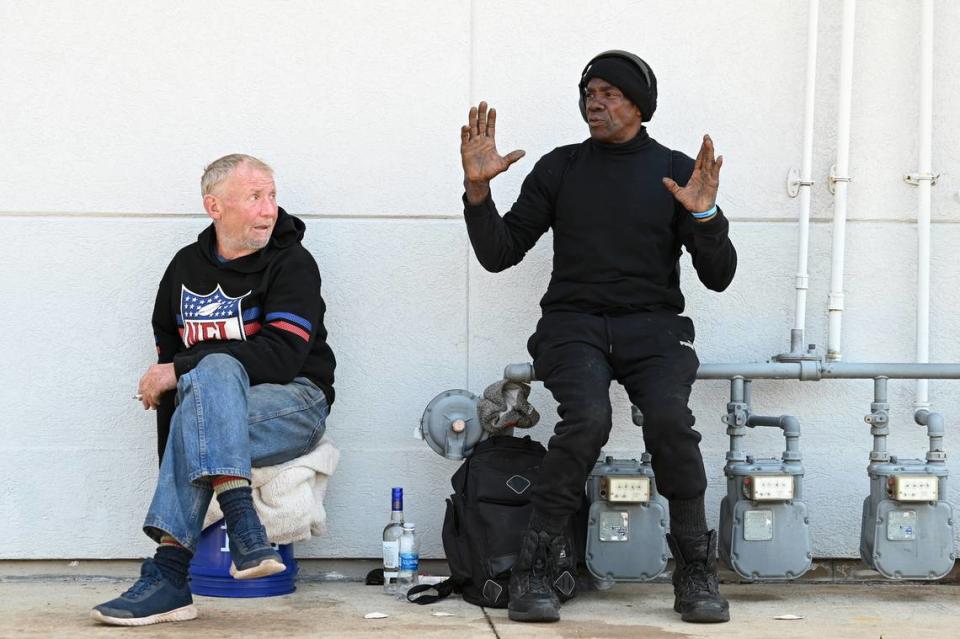
‘We’re just trying to survive’
Last summer, Lefty and Kenny were among the handful of inhabitants of a mini-tent city barely 100 yards away — where an old Exxon station then stood, on the northwest corner of Woodlawn and South — when police suddenly showed up one day in July and ran them all off of the property.
The others sought life elsewhere. Kenny and Lefty simply migrated across the street.
They offer a general impression that they’ve stuck together because using a buddy system helps lessen the inherent risks of being homeless. When out of earshot of Lefty, though, Kenny will tell you he felt compelled to watch over Lefty because of his disability: “I’m mainly his protection,” he explains, “for his other arm.”
The median they work focuses on cars heading northbound on South Boulevard and waiting to get a green arrow to turn left.
The men follow a basic panhandling formula, one that will look familiar to anyone who has driven in an urban area in Charlotte. When Kenny’s out there, for instance, he waits at the head of the median for the light to turn red, then ambles down the island waving his hand while holding handmade signs. The one he flashes to passersby on this March day reads, “Jesus Saves | but you must believe and call on him.”
It’s difficult to get an accurate estimate of how much money they make on an average day.
Lefty claims that the two of them combined often collect just a few dollars (and almost never more than about $10) per day — although he also says he buys himself a bottle of bottom-shelf vodka every day that costs $5.08 after tax, which wouldn’t seem to leave enough cash left over for them both to get something to eat.
Kenny says there are certainly exceptions: One guy gave him $50 in one pop, then followed him to a nearby QuikTrip gas station to make sure the donation was actually being used to buy food. (Kenny says it was, indeed.)
As for consistently profitable days for panhandlers, the guys agree that they are possible, saying some generate $100 a day or more. But they also say they believe there’s a network of people who collude in a panhandling “scam” throughout the city that typically involves toting babies or small children who serve to tug on the heartstrings of passersby. Kenny claims, as one example, that he recently observed a woman with a sign and a baby collecting “buckets of money” from motorists before watching her retreat, he says, to a shiny-looking Mercedes-Benz parked in a nearby lot.
He and Lefty, meanwhile? “We’re just trying to survive.”
Still, they’re out on the median a lot less often than you might imagine.
Sometimes it’s weather-dependent; it can be bitterly cold in winter, brutally hot in summer, and rain can reduce the likelihood drivers will roll down their windows. Sometimes they’re checking on their belongings, since they say other people experiencing homelessness have stolen from them repeatedly. Sometimes they’re gabbing with other assorted colorful characters who frequent the area.
Or often they’re simply trying to get some daytime shut-eye — since sleeping out in the open at night has risks.
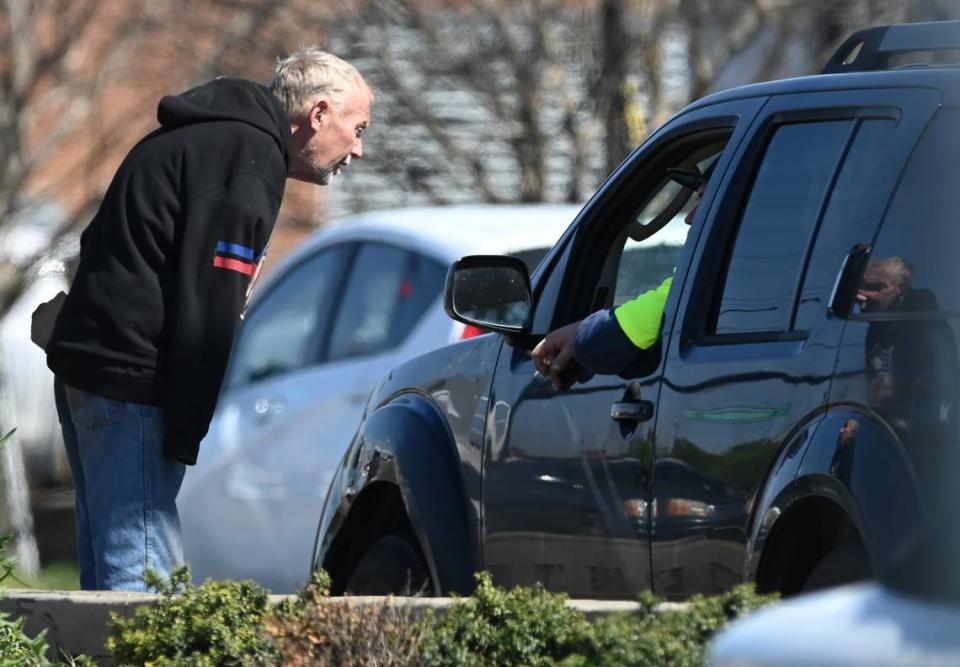
How did they wind up on the streets?
Lefty has been experiencing homelessness, he says, for much of his adult life.
At 5, he fell into a saw machine that cut his arm into three pieces. At 11, his father died. At 16, his mom died. The deaths devastated him, and because his siblings were all older and established in their lives, he quickly drifted out of touch with them and onto the streets of Charlotte.
His only respite came when he landed an apartment through Mecklenburg County’s Shelter Plus Care program, but he says he was kicked out because he kept letting “unwanted people” hang out and stay in his unit.
As for Kenny, he says he earned a bachelor’s degree in physical education from Lehman College in the Bronx in 1984, but then discovered crack cocaine and wound up getting in trouble with the law: He served four years in the New York state prison system in the mid-’90s for committing burglaries and robberies, and then several more years for similar convictions in the 2000s.
After he got released and relocated to the South, he says, he was never able to land any sort of steady employment due to the assorted felonies on his permanent record.
He says before falling into homelessness about nine years ago, he was living with his wife in a $1,500-a-month apartment at Sabal Point in Pineville that was being paid for by his Social Security Disability Insurance. Then in 2014, a combination of bad financial decisions sent them spiraling into $10,000 worth of debt. He says Crisis Assistance Ministry bailed them out and put them on a payment plan, but claims that his wife’s refusal to contribute to paying down their debt and her decision to leave him is how he ended up being forced out onto the streets.
Asked why they’re not trying to get into a shelter, they say it’s because the shelters are either full, or are more trouble than they’re worth because they have to leave first thing in the morning.
Liz Clasen-Kelly, CEO of Roof Above, says two of the interfaith nonprofit’s three year-round emergency shelters “remain full and there is a ‘lottery’ process in which men put their name on a list to request a bed — it generally takes a couple of weeks to get an assigned bed”; the third, she says, is an overnight-only shelter that offers beds on a first-come first-served basis and closes from 8 a.m.-4:30 p.m. every day.
So, living on the streets it is, the men say. And in an area of Charlotte that is a far cry from upscale, their presence stands out.
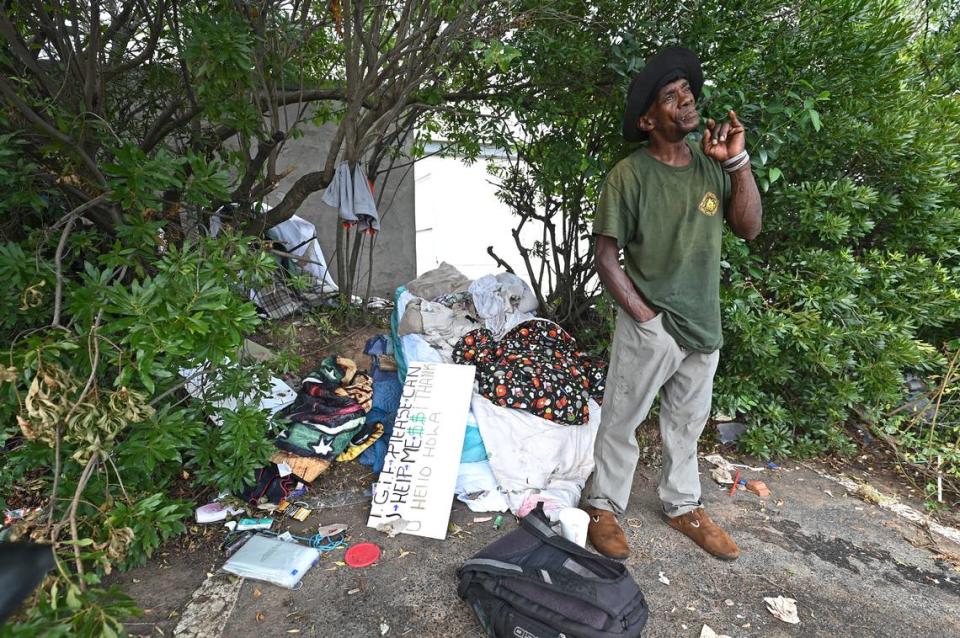
‘We watch all this strip here’
Everything they own — big black garbage bags full of clothing, tools, tarps, blankets, boxes, Kenny’s bicycle, spare parts for that bicycle — is strewn around in piles among the small trees and large shrubs next to Woodlawn.
When they sit down to take breaks to smoke cigarettes and drink alcohol behind Cricket Wireless and GameStop, you can’t see them from South Boulevard; but they’re in plain view of the Burlington and T.J. Maxx stores. It’s also not uncommon to see them sleeping right in front of a store in broad daylight, during non-business hours.
But Kenny describes how and why the pros seem to outweigh the cons for the “neighborhood.”
“We watch all this strip here. We try to clean up and (act as) security and stuff like that,” he says, and as if on cue, an employee of the Boost Mobile store comes out of the rear entrance and proceeds to engage in friendly chatter while she puffs on a cigarette.
After she heads back inside, Kenny continues: “If any cops come through here, they know us by name. They know that since we’ve been doing this, there’s no criminal activity. There’s no drivers calling and saying we’re harassing them. ... Now, you go to Beatties Ford and Freedom Drive, them people are actually fighting to get on the median. They fighting between each other. People drive by and see that, and they’re gonna call the police.”
Michael Allinger of the Charlotte-Mecklenburg Police Department’s public affairs office says CMPD officers do not currently issue citations to people who are panhandling, but adds that “if they commit other crimes while we’re out there, we can certainly enforce other things.”
He and Lefty have been “flying” this particular median long enough, Kenny says, that they’ve earned the respect of others — it’s extremely rare for anyone to try to move in on their turf, and when it’s happened, he claims they’ve let the person earn a few dollars and then politely asked them to move on.
Never, Kenny says, has anyone ever given them trouble about it.
“There’s unity here. That’s why we don’t go anywhere else.”
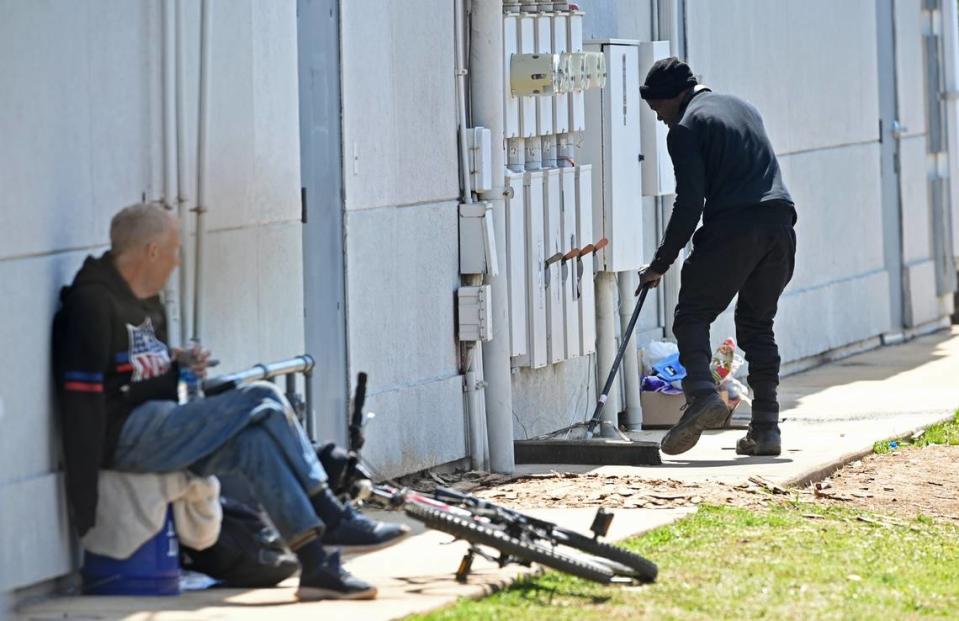
Suddenly a one-man show
Then one day in mid-July, Lefty did, in fact, go somewhere else.
Kenny explains that he knows exactly where that is — under the bridge by the light rail station at I-485 and South Boulevard — and why he’s relocated: because of an uptick in violence in the area and Lefty having concerns about his safety there. And as further proof that the unity and the peace he described in the spring has since fractured, on this day Kenny points to blood on the ground, spilled by another homeless man who was stabbed in a dispute.
But Lefty will return, Kenny promises. And in the meantime, for Kenny, life continues on in this tiny pocket of Charlotte.
He excuses himself and disappears into the Arby’s, then emerges a few minutes later pushing a cart full of bagged trash from the restaurant to the dumpster behind it. After going back inside to return the cart, he comes out talking with an employee and carrying a sack of hot food.
“I do the garbage, I clean the bathroom,” he says as the employee heads back inside. “So I can go in there and order whatever I want to order free of charge. ... I can go right in Arby’s and order whatever I want, for 50 people. They’re not gonna question me.”
In some ways, Kenny seems more resigned than ever to point himself in a direction that will lead him off the streets. He says the owner of a nearby self-serve car wash has promised him a weekend job cleaning grates, and that he’s hoping to use his earnings to get himself set up in an extended-stay hotel.
As he says this, though, he’s pouring himself a beer — at 2 o’clock on a Wednesday afternoon.
He also reveals that he is still wrestling with his addiction to crack cocaine.
“I gotta stop the drugs and all that,” he says, as he tops off his cup with a few more ounces of canned beer. “I have to make a decision, man, of what I need to do. I don’t wanna die messed up. Just that simple. There’s more to my story than this.”
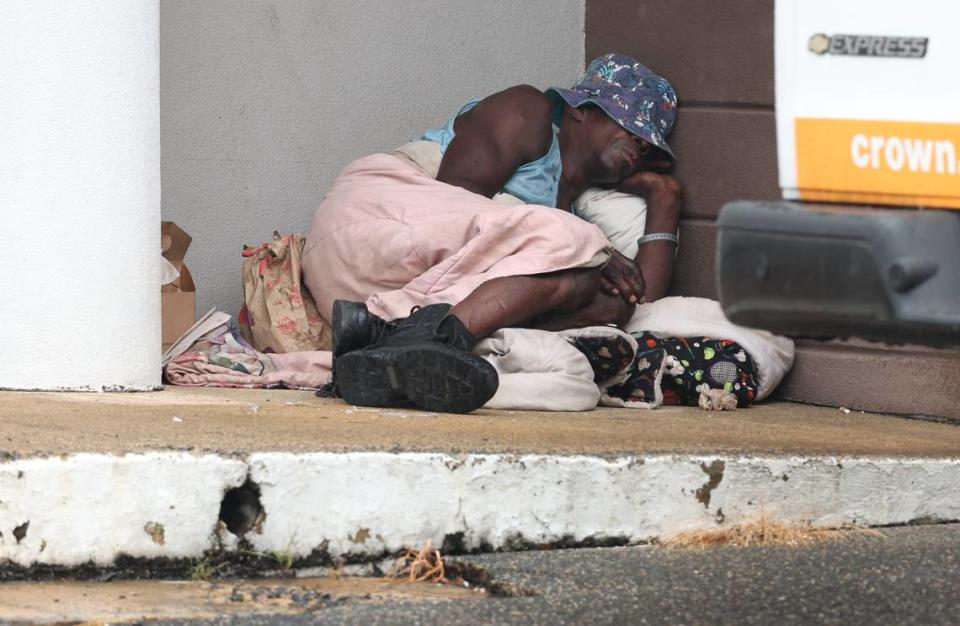
‘I told him I was comin’ back’
On multiple visits to the underpass near the light rail station, there was no sign of Lefty.
Yet, as Kenny had predicted, his pal suddenly returned to the intersection at Woodlawn and South in August. Lefty confirmed he was living under that bridge for a good deal of the time, but also claimed that he had spent a total of 12 days in a hospital over the course of two separate visits — one because he had congestive heart failure and the other because he had a heart attack.
On this early-September day, though, he looked no less healthy than he had back in March, lounging in a collapsible chair on the Walgreens property across South from their usual spot.
“There were some people up here acting crazy,” Lefty says, vaguely confirming Kenny’s explanation as he watches the cars go by. But “I’m back home.”
When “I told him I was comin’ back, he said, ‘Thank God!’” Lefty continues, laughing.
The idea of trying to get into a shelter comes up again, but as before, Lefty just waves it off. He says he survives better on the streets.
As for Kenny ...
More desperate than ever before
Back in August, while Lefty was on his hiatus, we had found Kenny camped out in the boldest place yet: Against the side of Arby’s during the lunch rush, in a spot that put him about even with the rear wheels of every vehicle that pulled up to the drive-thru window. It was raining, but just lightly. He rose to his feet and strode toward us.
“I need a couple of dollars, man, ’cause the rain, it’s stopping me,” he explained.
We offered to pay for whatever he wanted, and inside, he ordered a five-piece fish meal (apparently, there are limits on the number of free orders they’ll give him, after all).
The subject of the job at the car wash came up. He said he still hadn’t started it yet. “Hopefully Saturday. If weather permits.”
He looked and sounded more desperate than ever before.
“I gotta move on,” he said. “Health is getting worse. I mean, I can’t keep on pushing it. You know what I’m saying? I can do better. Hopefully, this car wash thing works. If it don’t...”
His voice trailed off.
A minute later, an employee handed Kenny his bag of food. Kenny took it, headed back outside, sat down once again next to the drive-thru window under an awning that would keep his fish and French fries dry, and began to eat.
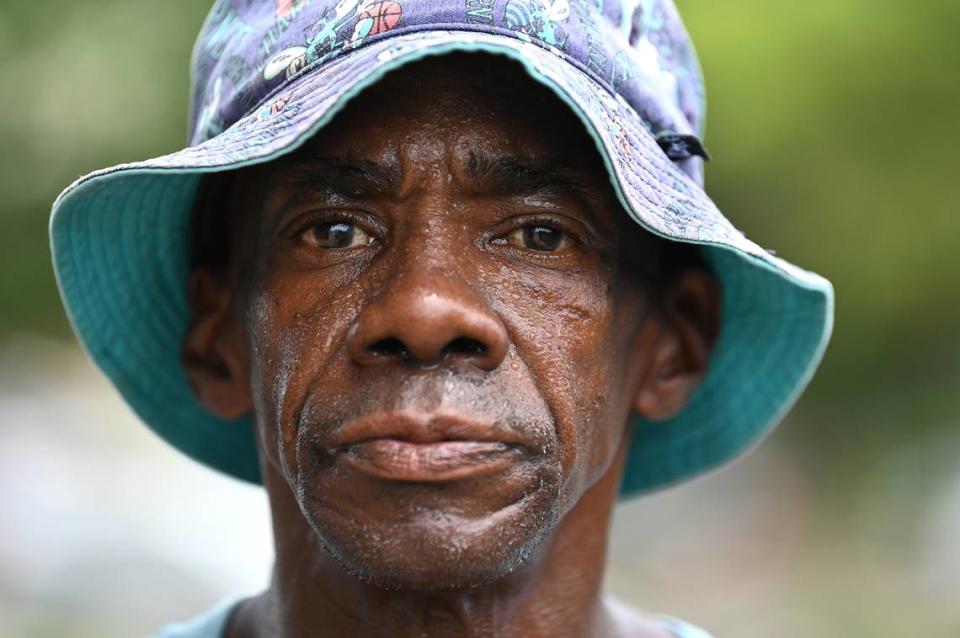
Additional reporting by Observer visual journalist Jeff Siner.


